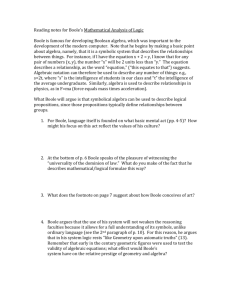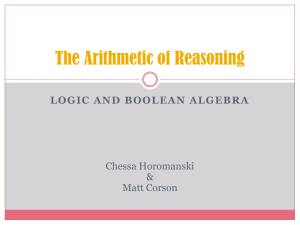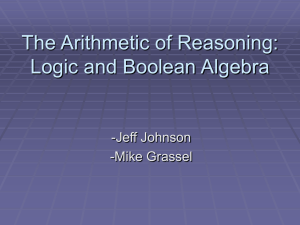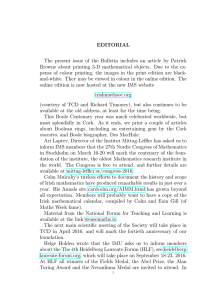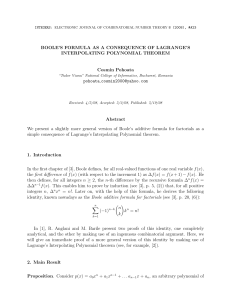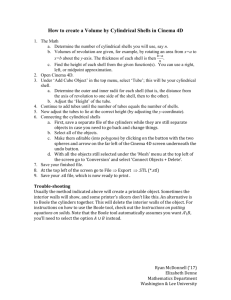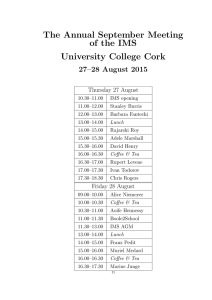Theory-driven historical discovery: Boole’s abstract formalization of Logic
advertisement
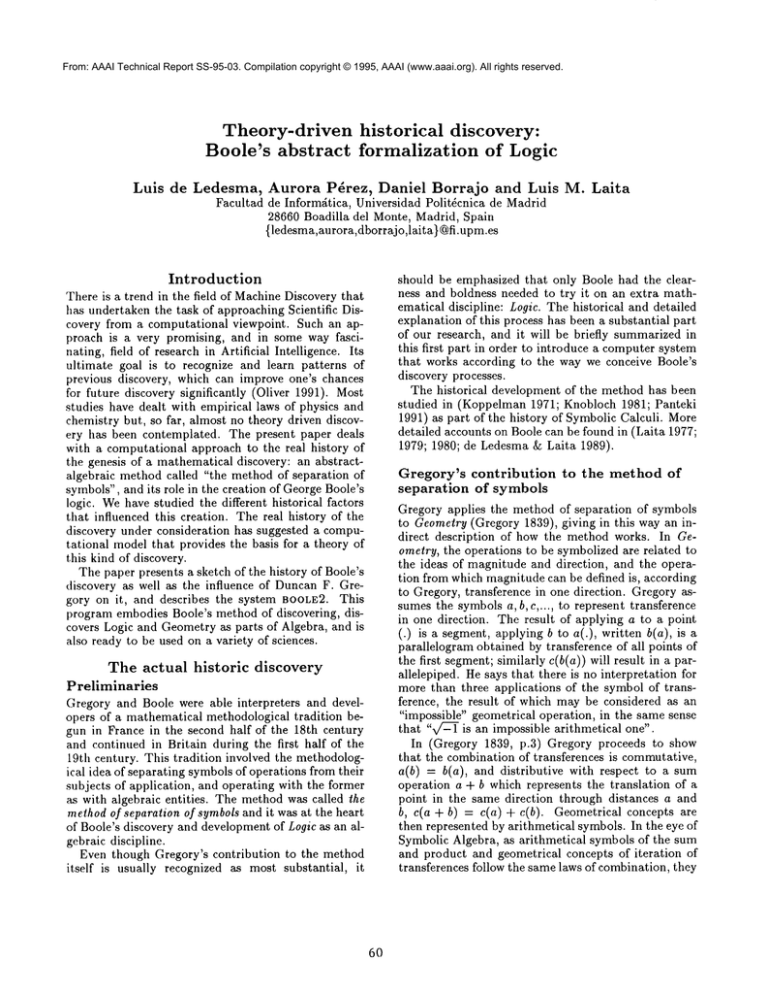
From: AAAI Technical Report SS-95-03. Compilation copyright © 1995, AAAI (www.aaai.org). All rights reserved.
Theory-driven historical
discovery:
Boole’s abstract formalization of Logic
Luis
de Ledesma,
Aurora P~rez,
Daniel
Borrajo
and Luis
Facultad de Informgtica, Universidad Polit@cnica de Madrid
28660 Boadilla del Monte, Madrid, Spain
{ledesma,aurora,dborrajo,laita)
@fi.upm.es
Introduction
There is a trend in the field of MachineDiscovery that
has undertaken the task of approaching Scientific Discovery from a computational viewpoint. Such an approach is a very promising, and in some way fascinating, field of research in Artificial Intelligence. Its
ultimate goal is to recognize and learn patterns of
previous discovery, which can improve one’s chances
for future discovery significantly (Oliver 1991). Most
studies have dealt with empirical laws of physics and
chemistry but, so far, almost no theory driven discovery has been contemplated. The present paper deals
with a computational approach to the real history of
the genesis of a mathematical discovery: an abstractalgebraic method called "the method of separation of
symbols", and its role in the creation of George Boole’s
logic. Wehave studied the different historical factors
that influenced this creation. The real history of the
discovery under consideration has suggested a computational model that provides the basis for a theory of
this kind of discovery.
The paper presents a sketch of the history of Boole’s
discovery as well as the influence of Duncan F. Gregory on it, and describes the system BOOLE2.This
program embodies Boole’s method of discovering, discovers Logic and Geometryas parts of Algebra, and is
also ready to be used on a variety of sciences.
The actual historic
discovery
Preliminaries
Gregory and Boole were able interpreters
and developers of a mathematical methodological tradition begun in France in the second half of the 18th century
and continued in Britain during the first half of the
19th century. This tradition involved the methodological idea of separating symbols of operations from their
subjects of application, and operating with the former
as with algebraic entities. The method was called the
method of separation of symbols and it was at the heart
of Boole’s discovery and development of Logic as an algebraic discipline.
Even though Gregory’s contribution to the method
itself is usually recognized as most substantial, it
60
M. Laita
should be emphasized that only Boole had the clearness and boldness needed to try it on an extra mathematical discipline: Logic. The historical and detailed
explanation of this process has been a substantial part
of our research, and it will be briefly summarizedin
this first part in order to introduce a computer system
that works according to the way we conceive Boole’s
discovery processes.
The historical development of the method has been
studied in (Koppelman 1971; Knobloeh 1981; Panteki
1991) as part of the history of Symbolic Calculi. More
detailed accounts on Boole can be found in (Laita 1977;
1979; 1980; de Ledesma ~ Laita 1989).
Gregory’s
separation
contribution
of symbols
to the method of
Gregory applies the method of separation of symbols
to Geometry (Gregory 1839), giving in this way an indirect description of how the method works. In Geometry, the operations to be symbolized are related to
the ideas of magnitude and direction, and the operation from which magnitude can be defined is, according
to Gregory, transference in one direction. Gregory assumes the symbols a, b,c,..., to represent transference
in one direction. The result of applying a to a point
(.) is a segment, applying b to a(.), written b(a), is a
parallelogram obtained by transference of all points of
the first segment; similarly c(b(a)) will result in a parallelepiped. He says that there is no interpretation for
more than three applications of the symbol of transference, the result of which may be considered as an
"impossible" geometrical operation, in the same sense
that "v/L-] - is an impossible arithmetical one".
In (Gregory 1839, p.3) Gregory proceeds to show
that the combination of transferences is commutative,
a(b) = b(a), and distributive
with respect to a sum
operation a + b which represents the translation of a
point in the same direction through distances a and
b, c(a + b) = e(a) + c(b). Geometrical concepts are
then represented by arithmetical symbols. In the eye of
Symbolic Algebra, as arithmetical symbols of the sum
and product and geometrical concepts of iteration of
transferences follow the same laws of combination, they
are identical (that is, belong to the same family). So,
whatever can be proved in arithmetic in dependence
of only those laws alone, is valid for the geometry of
transference.
Boole and the method of separation
of
symbols
Boole’s awareness of the advantages of facing mathematics as a calculus of symbols began very early in his
life. In 1835, when he was twenty years old, he gave an
address on Newton which seemed to refer to Boole’s
own philosophy of mathematics as much as to Newton’s. The ideas on the necessity of a systematic use of
symbolismas well as the possibility of separating the
use of symbols from their interpretation were already
there.
In 1839, Boole went for a trip to Cambridge and
met the mathematician Duncan F. Gregory, who recently had founded the Cambridge Mathematical Jour11al. Boole submitted several papers for publication
and the latter saw with astonishment that Boole had
developed by himself-influenced only by his readings
of Lagrange and other French mathematicians- an approach to mathematics very similar to the one developed at Cambridge. Reading, for instance, the paper
(Boole 1841), is a fascinating experience on the application of an abstraction of the analytical change-ofvariables technique to the symbolic transformation of
a curve’s equation.
The examination of some of Boole’s subsequent papers shows that it was by this time when Gregory informed Boole of the particular traits of the method
of separation of symbols. Boole recognizes that Gregory was his inspirer, but he went much further than
Gregory. He applied the method to some truly difficult problems in the differential calculus and the calculus of finite differences. And, what is most import.ant, Boole made this bold guess: symbolic calculus,
and the method of separation of symbols in particular, could be applied outside mathematics, particularly to Logic. The reason that made Boole return
his attention to Logic was a controversy about a logical subject between the philosopher William Hamilton
and the mathematician Augustus De Morgan. He had
been interested in Logic muchlonger before: "... I was
induced by the interest which it (the controversy) inspired, to resume the almost forgotten thread of former
inquires", (Boole 1847, p.1). And it is of utmost importance to see how, this second time, Boole founded
Logic on the method of separation of symbols. As a
matter of fact, the first principles of Logic as they appear at the beginning of the book The Mathematical
A~alysis of Logic (Boole 1847) are an almost direct
transcription of laws suggested by Gregory in his version of the method of separation of symbols. Boole
writes at the beginning of the mentioned book:
Further, let us conceive a class of symbolsx, y, z,
possessed of the following character. The symbol
61
z, operating upon any subject comprehending individuals or classes, shall be supposed to select
from it all individuals of the class X which it contains...
Whenno subject is expressed, we shall
suppose 1 (The Universe) to be the subject understood, so that we shall have z = x(1). The
result of an act of election is independent of the
grouping or classification of the subject... Wemay
express this law mathematically by the equation
z(u + v) = zu + zv. It is indifferent in what order two successive acts of election are performed.
The symbolic expression of this law is xy = yx.
The result of an act of election performed twice
or any number of times in succession is the result
of the same act performed once.., supposing the
same operation to be n times performed, we have
x~ = z. (These) laws are sufficient for the basis
of a calculus... The third law z n = x we shall denominate the index law. It is peculiar to elective
symbols and will be found of great importance ..
(Boole 1847, pp.15-18).
The last sentence in this quotation states how Logic
turns out to be a calculus governed by the same laws as
some of those in the method of separation of symbols.
This is not just a fancy abstract statement. Actually,
the whole book (Boole 1847) is a complete development
of an Algebraic Logic on the basis of precisely those
three laws.
Boole’s discovery consisted of finding that Logic
was among the sciences worth of symbolization. This
means that its basic operations follow the same laws
of combination of symbols as some of the families in
Symbolic Algebra. From this point of view, Gregory’s
finding on Geometry can be considered as just another
instance of the same process.
Description
of BOOLE2
According to the extensive research that we have done
about the life and work ofG. Boole, we built first a program, BOOLE1,that, following Boole’s reasoning process to the Mathematical Analysis of Logic, reached the
same conclusions as he did (de Ledesma et al. 1993).
This reasoning process tried, and succeeded, in applying the Methodof Separation of Symbols to Logic. Since
it was our firm belief that -in Boole’s view- the process of finding whether a science is symbolizable or not
(whether the method of separation of symbols is applicable to it or not), is always the same, we undertook
the task of generalizing BOOLEI’sheuristics to make it
applicable to other sciences as well. Duncan F. Gregory’s Geometry was chosen as a first instance. Gregory was not selected as the active agent of a discovery
process to be formalized by a computer program (our
purpose was to reach the conclusion of his Geometry
being symbolizable by an emulation of G. Boole’s reasoning), but as the author of a branch of Geometry
particularly apt for our intention.
The formalization of the just mentioned ideas and
aims resulted, then, in a program, BOOLE2,that using
a uniform way of representing and reasoning is able to
discover that both Logic and Geometry are symbolizable (de Ledesmaet al. 1994). In fact, its representat.ion and reasoning tools are intended to handle any
science ms a candidate for symbolization, provided its
basic contents can be turned accessible to the system.
In this way, the so called generic part of the system may
be viewed as a module that has information about the
method of separation of symbols, explicitly including
the knowledgethat is commonto all sciences, i.e., a
scheme designed to receive each specific science as an
input: operations, combinations and the possible laws
thereof. This enlarges the applicability of the system to
different environments, besides Logic. So far, BOOLE2
has been provided with understanding on the way Gregory conceived Geometry. In this manner, it considers
Geometry as a candidate for symbolization and reaches
the laws of combination of the basic operation, transference, as stated by Gregory in (Gregory 1839), plus
the conclusion of such Geometry being symbolizable.
The main difference between BOOLE2
and other systems dealing with the process of scientific discovery
such
as BACON,
GLAUBER,
STAHL
and DALTON, (Langleyet al.1987),AM andEURISKO(Lenat1982)or
(Shen1990),is thattheformeris exclusively
guided
l)ythetheory,
instead
of experimentation,
i.e.,it is
nota datadrivendiscovery
system.
First,andhaving
illmindthat"datadriven"
refersto theexperimental
character
of theinput,BOOLE2’s
inputis an abstract
representation
of thescience
to be considered.
On the
otherhand,a substantial
partof itsheuristics
stems
fromtheoryandit shouldbe emphasized
that,in this
case,theorymeansthe veryprecisesymbolic
wayby
whichBoolehandled
themethodof separation
of symbols.Themethodis a partof Mathematics
and,therefore,demandsan abstract
wayof reasoning.
BOOLE2’s
starting
pointis theknowledge
andgoalsprevious
to
thediscovery
of a science
beingsymbolizable
or not,
andit endsstating
whether
themethodof separation
ofsymbols
is applicable
to itor not.Morespecifically,
it startsfromthestateof mindof G. Boolebefore
"TheMathematical
Analysis
of Logic"andit reaches
theconclusions
abouteitherLogicor Geometry
by an
emulation
of Boole’s
ownreasoning
process.
The aboveparagraph
makesclearwhicharethe inputandoutputforthesystem:
theinputis a descriptionof the sciencewe wantBOOLE2to consider
(its
operations,
combinations
andso on);theoutputis
record
of itsalgebraic
properties
plustheconclusion
of suchscience
beingsymbolizable
or not.Letus examinea firstsketch
of theprocess
thatleadsto such
an output.G. Boolealwaysseemedto perfectly
know
hisobjectives
andto havetheability
to separate,
in
ahuost
everyinstance,
therightpathto themfromthe
infinity
of allotherconceivable
wrong,useless
or undulylongpaths.
Thisis thespirit
thathasbeengiven
62
to the BOOLE
systems. Their heuristics are just the
insightful reasoning method of Boole.
The process of execution of BOOLE2may be described as follows. The initial goal is to incorporate
a science to the set of symbolizable ones. Since this
goal is not true yet, the system tries to achieve it by
checking first whether the science deserves to be symbolized (a new goal: "worth of symbolization").
this way, the top level goal needs a numberof subgoals
to be true, that, in turn, will need other subgoals and
so on. This backward process is based on the above
remarks on George Boole’s reasoning. The execution
ends when the top level goal is attained. The achievement of each goal simulates one step of the discovery
process. Figure 1 shows the top level part of the subgoaling structure of BOOLE2’s
reasoning.
~
~
corporate
Scienceto~
Symbolization
/
ributi~ve
Figure 1: Top level part of the subgoaling structure
generated by BOOLE2when reasoning
The program has been formalized as a production
system, with its three classical components: working
memory,set of rules, and control. Its knowledgeis divided in two: a generic part, and a specific one. The
generic part is a set of rules and frame descriptions,
commonto any science, while the specific part is composed of a set of rules and frame descriptions for each
particular science. This is precisely one of the strong
points of the system, since it allows to create a discoverer for each science given a set of instantiated operations on that science. Figure 2 shows the architecture
of the system.
The set of initial facts of the working memorycomprises the set of all facts in Logic and Geometryprior to
their consideration as symbolic disciplines. The intermediate and final sets of facts represent the different
states of mind of the human scientist on his or her
reasoning process. The set of rules describes the individual steps of the general process of finding whether a
particular science can be symbolized or not, and howto
perform simple operations on the respective sciences.
The control mechanism guides BOOLE2towards the
same kind of reasoning that G. Boole used.
Remark on vocabulary.
The term operation is used in this context in a different sense than the usual one. This is due to historical
reasons and reflects G. Boole’s conception of sciences.
An operation means something close to the modern
BOOLE2
SCIENCE
Genetic Fram~
SpecificRul~
SpecificFrames
LogicWorking
Memory
LogicRuleSet
Geome~’y
Working
Memory
Geomel~
Rule Set
OtherSciences
WorkingMemory
OtherSciencesRuleSet
/
I
LOGIC
......
X
v
......
-7.’--......
--L~;=~:’---’CLASS
.........
Z
C, enencRul~s
RESULT-OF~LASS--==::_-:..............
~-Rc,sull
[
.......
’
4 - Re.soiln
PART-OF-CLASS
.......
SIMPLE-OPERATION
COMPLEMENT-OF-CLASS
Comm(m
W(a-king
MemL~/
ii
.." Succ~sion
i
PROTOTYPE-COMBINATION
COMBINATION
~
’Q" Aggregation
¯ Separation
COMBINATION-INSTANCE
i
.... ~ - Commula[ivc[
.............
~ Commmativen
COMMUTATIVE_.~-_-..’2
.............
~" - Distribuliv¢l
..............
-. Dis~rihtlliv¢ n
LAW ~ D[STIIIBUTIVE-~=:--::’..’-’[DEMPOTENCE
-~l==:.~:::
::-7.:’: .........
~- I(lennlx~tence
INDEX~ .~..~_: _: _ ~_~_
.........
~"]dcmpotcncc
n
"- ....
- ..... 7-hldcxl
n..... !.- Index
Common
RuleSet
Frulekit
CONTROL
..........
Figure 2: Architecture
t- Comrol
of BOOLE2
a
b
Figure 3: Hierarchy of frames on BOOLE2
for Logic
idea of operator. For instance, differentiation, is an operation of Calculus; taking the trace of a point moving
through a segment is an operation of Geometry ("transference"); and selecting a class of individuals from
universe is an operation of Logic ("class"). Notice that
the effect of the operations in the three previous examples are the well knownconcepts of derivative, segment
and predicate (identified with a set of individuals).
On the other hand, we use the term combination (of
operations) nmchin the sense of today’s algebraic operation. For instance, two successive acts of selecting
individuals from class x, first, and, then, from class
y ("class succession") yield the class of the individuals which are both x and y; and two translations of a
point through different directions ("transference andin-other") yield a parallelogram.
SCIENCE
Working
Memory
J GEOMETRY
." a
TRANSFERENCE"
~*~’Z -:
REVOLUTION....... r
SI.EOFERATION
SO.ANSFERENCE
.......:-::::::::-:".-;:’:":’n
¯ "And-in
-other
PROTOTYPE-COMBINATIONAnd-ln-the-same
COMBINATION
i
COMBINATION-INSTANCE
... i ~ - Commulalivel
...........
..............
~,
n Colluntllalive
COMMUTATIVE
~--"----" .............
~- Distrihulive[
~. Dislrihufiv¢n
LAW ~ DISTRIBUT1VE-~¢--’---:-’--..............
IDEMP(ITENCE.... =¢~:~.7. 2::: ......
...........
~"
i - Idcml~)tcnc¢l
INDEX ~.-~ ....
" .... ~. idcmpotcnccn
:----: ......... -- [,,d¢~
CONTROL...........
a
The
/
f
:
Conlro]
i
h
Figure 4: Hierarchy of frames on BOOLE2
for Geometry
Tile state of the working memoryat a given moment
of the execution of the production system represents a
corresponding mental state of the discoverer in his/her
reasoning process. In 8OOLE2,the working memoryis
composedof a set of frame descriptions, together with
a set of instances of those frames. Figures 3 and 4 show
the hierarchy of frames.
The working memoryis divided in three parts: static
science-independent, static science-dependent, and dynamic. The static science-independent part is composed of the hierarchy of frames that is commonto all
sciences just before the process starts, i.e., the generic
frames. This is shown in figures 3 and 4 by the set
of frames that are on section a. The static sciencedependent part is the set of specific frames and instances, created for each science in the initial state.
This is shown on the figures by the set of frames and
instances that are on section b. Finally, the dynamic
part is composedof the specific instances that are created at run time, represented on section c.
As an example of frame and instance descriptions,
figure 5 shows a science-independent
frame and a
science-dependent instance. Namely, the frame sci-
63
ence, which has the description of the science, and
the instance succession, which has the information
on a combination of simple operations of the science
Logic. The frame slots are self-explanatory.
Nevertheless, someof the instance slots require a better understanding of how BOOLE2
handles the combinations
of simple-operations.
WhenBOOLE2
decides, through
the rules, that a combination should be applied on
two simple-operations, it creates a notation for each
simple-operation. The notation is computed using the
function value of the slot notation-generator-1 of the
corresponding combination.
A comment should be made on how Logic has been
represented as an input to BOOLE2
(similar comments
can obviously be given for Geomeiry, but we are referring to just an example). Any science representation
must first state which is the operation, or operations,
to be considered as simple. The simple operation for
Logic is the class. According to Boole’s ideas, each
class, named x, represents both the act of selection
of all individuals X included in that class, as well as
;;; Framethatdescribes
a generalscience
(literalize
science(:cache:*ALL*)
:namenil
:simple-operations
nil
:combinations
nil
:lawsnil
:worth-symbolization-p
nil)
;;; Instanceof the frameprototype-combination
;;; namedsuccession.
It describes
how to perform
;;; a succession
on two simple-operations
on the
;;;scienceLogic.
($make’prototype-combination
:name’succession
:meaning’succession
:science
’logic
:notation-generator-1
#’succession-ng
:result-generator
#’succession-rg)
Figure 5: A frame and an instance in BOOLE2
tile result of that act (the set formed by, exactly, all
individuals X). One of the notations used for, both,
representing and handling x is the list (ALL THAT
AREX). Whysuch an "essentialist"
representation?
It. is intended also to reflect Boole’s abstract way of
reasoning. It is possible to represent aggregation of
classes as set union and infer by a short induction the
same results obtained by BOOLE2,but that would be
unloyal to the sort of linguistic way in which G. Boole
handled this combination of operations (the aggregation of two classes). On the other hand, this notation,
as well as the others that have been chosen, has shown
to be particularly apt for a transparent representation,
and also for performing the different combinations.
Rule set
The rule set is divided in two subsets: discovery rules,
and recording rules. The discovery rule set is composed
of rules that reason along the set of processes that can
be applied to the elements of a science, and can be
divided into the following sets:
¯ General rules. They control the abstract reasoning
for considering a science worth symbolizable.
¯ Law rules. They represent the commonlaws for
the sciences, such as commutative, distributive and
idempotence.
¯ Combination rules. These rules perform the default combinations over the operations of the sciences. In particular, for the science Logic, the combinations are succession, and aggregation, and for
the science geometry are and-in-lhe-same-dimension
and and-in-other-dimension.
¯ Forced combination rules. These rules act as
heuristics of discovery in the sense that they provide
a way of combining operations when certain conditions hold. As an example, the forced-succession rule
64
is a heuristic that says that the system should perform the combination of two operations 02 and ol,
if it has already performed the combination of ol
and 02; this will help to fire the rule relative to the
commutative law if the results of both combinations
are the same.
¯ Continuation rules. These are rules that control
the way in which rules are matched. They provide a
control above the one supplied by the agenda mechanism. In particular,
they do not allow the same
type of combination to be applied twice in a row
whenever another rule can be fired.
The second kind of rules, the recording rules, are
rules that collect all laws that are satisfied in a certain
science.
Control
mechanism
The control of the execution is done through an agenda
mechanism.Rules are organized in priority levels, usually with more abstract rules on higher levels of priority, and more detailed rules in lower levels of priority.
Figure 6 shows the different levels with the type of
rules on each level.
Recording rules
General rules
Law rules
Forced combinations rules
Combination rules
Continuation rules
Figure 6: High level description of BOOLE2’s
agenda.
The agenda follows a priority policy, by which the
rules on each level are matched to see if anyone can
fire. 1 If no rule of a certain level fires, the control goes
to the next level. As soon as a rule of a certain level
fires, the control goes to the highest level, in order to
see if any of the high level rules can fire.
In order to suplement the agenda with more complex ways of control, BOOLE2
has the forced combination rules and the continuation rules. The first type
of rules plays the role of heuristics based on the state
of the search. They allow to control how to apply the
discovery rules in a similar way to the one used by G.
Boole. The second type of auxiliary control rules allow
to explore the search space uniformely, not repeating
the same basic step (combination) twice without trying
out different combinations. These two types of heuristics are useful for guiding the process, and relating it
to the real discoveries.
Conclusions
The main contributions of the research, are:
1Frulekit uses a Rete net for efficiently matching the
rules.
¯ We have carried out an accurate and detailed study
of the work of a human scientist,
George Boole, in
his particular
view of the Method of Separation of
Symbols, its scope and actual applicability
to a science, Logic, which was not considered, by that time,
as a mathematical discipline.
to improve our work.
References
Boole, G. 1841. Researches on the theory of analytical
transformations.
Cambridge Mathematical Journal Ih6473.
Boole, G. 1847. The mathematical analysis of logic, being an essay towards a calculus of deductive reasoning.
Macmillan, Barclay, and Macmillan.
de Ledesma, L., and Laita, L. M. 1989. George Boole.
From differential
equations to mathematical logic. In
Actas de la Reunidn Matemdtica en honor de A.Dou,
341-352. Madrid: Publicaciones de la Universidad Complutense.
de Ledesma, L.; Laita, L. M.; Pdrez, A.; and Borrajo, D.
1993. Descubrimiento cientffico e inteligencia artificial.
Real Academia de Ciencias Exactas Fisicas y Naturales
115-132. Proceedings of the Segundo Curso de conferencias sobre Inteligencia Artificial.
de Ledesma, L.; Pdrez, A.; Borrajo, D.; and Laita,
L.M. 1994. La 16gica de Boole como consecuencia del
m~todo de separaciSn de sfmbolos de Gregory-Boole. Estudio hist6rico y su emulaci6n por computador. In Contra los titanes de la rutina. Contre les titans de la routine. Proceedings of the CongT~eso Hispano-Francds sobre
la Historia y la Filosoj~a de la matemdtica. Comunidadde
Madrid/CSIC. 287-300.
Gregory, D. F. 1839. On the elementary principles
of
the application
of algebr~c symbols to geometry. The
Cambridge Mathematical Journal 2:1-9.
Knobloch, E. 1981. Mathematical perspectives,
Essays
on Mathematics and its historical
development. New
York: J.M. Dauben. chapter Symbolik und Formalismus
im mathematischen Denken des 19. und beginnenden 20.
Jahrhunderts, 208-216.
Koppelman, E. 1971. The calculus of operations and the
rise of abstract algebra. Archive for the History of Exact
Sciences 8.
Laita, L. M. 1977. The influence of Boole’s search for a
universal method in analysis on the creation of his logic.
Annals of Science 163-176.
Laita, L. M. 1979. Influences on Boole’s logic, the controversy Hamilton-De Morgan. Annals of Science 45-65.
Laita, L. M. 1980. Boolean algebras and its extralogical
sources. History and Philosophy of Logic 37-60.
Langley, P. W.; Zytkow, J. M.; Simon, H. A.; and Bradshaw, G. L. 1987. Scientific
Discovery. Computational
Explorations of the Creative Processes. MIT Press.
Lenat, D. B. 1982. The nature of heuristics. Artificial
Intelligence 19:189-249.
Oliver, J. E. 1991. The Incomplete Guide to the Art of
Discovery. NewYork: Columbia University Press.
Panteki, M. 1991. Relationships between Algebra, Differential Equations and Logic in England, 188-1860. Ph.D.
Dissertation, Council for National Academic Awards. UK.
Shen, W. M. 1990. Functional transformations
in AI
discovery systems. Artificial Intelligence 41:257-272.
¯ The study gave us the guidelines
to build a computational model that behaves like the scientist
G.
Boole in a given reasoning process, such as considering a science symbolizable. The resulting program,
BOOLE2,behaves like a re-discoverer,
in the sense
that it reproduces real scientific discoveries. The execution of BOOLE2with Logic as an input proves that
the system is able to go all the way from the starting point to the conclusions of Boole himself. This
shows that the knowledge given to the program by
the authors of this paper is sufficient
for explaining the way George Boole got to his discovery and,
therefore, that BOOLE2itself is an approximation to
a theory of this scientific discovery.
¯ The results
showed us that the process is general
enough to be translated
to other sciences, by just
entering the initial
description of the science to be
considered.
This has been the case for Gregory’s
Geometry.
We would like to emphasize that, even though the
system does not mimic a large number of case studies, it captures an interesting level of detail for those
that are actually
studied.
Just because this sound
ground of detailed conceptualization,
it can be considered as potentially able to handle other cases as well.
The separation-of-symbols
heuristic
has been consistenly used from 19th century on with the label of "forrealization"
or "abstraction".
Whenever a portion of
knowledge is symbolically represented and its symbols
("separated" from the particular
meaning they have in
their domain) are found to behave in the same way
as those of, say, Logic, Algebra, Graph theory, etc., a
separation-of-symbols
process has been carried out. It
is in this sense that any science can be considered as a
candidate-input
for BOOLE2.Due to their low level of
formalization,
Boole’s contemporary sciences are more
fitted than others to the spirit of the present study. De
Morgan’s Logic is an excellent candidate for both its
proximity in terms of personal relationship
to George
Boole and, at the same time, its almost null algebraic
character.
But any other discipline
might be considered as well. There would always be an output, "it is,
or it is not, symbolizable", provided we had devised an
appropiate representation
of such discipline,
which is
by no means a trivial task.
Acknowledgments
We owe thanks to Prof. Herbert A. Simon, for encouraging us in the past to undertake the task of creating the
systems BOOLEand for many subsequent and extremely
fruitful discussions prior to this paper, and to Prof. Raul
E. Valdds-P6rez whose helpful comments have contributed
65
